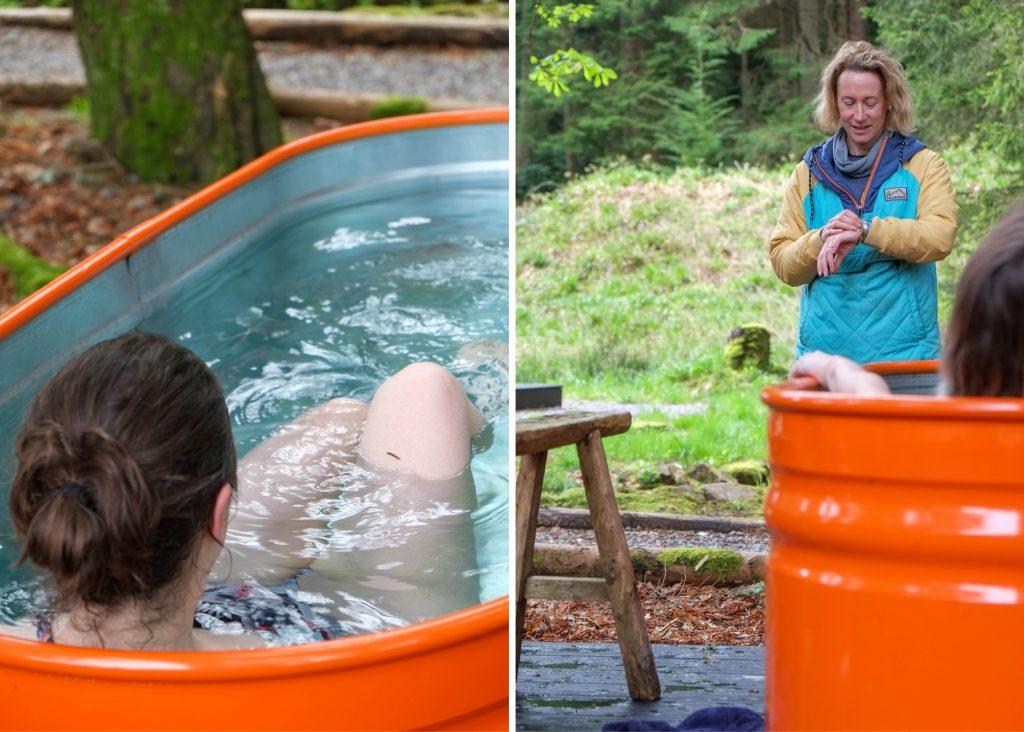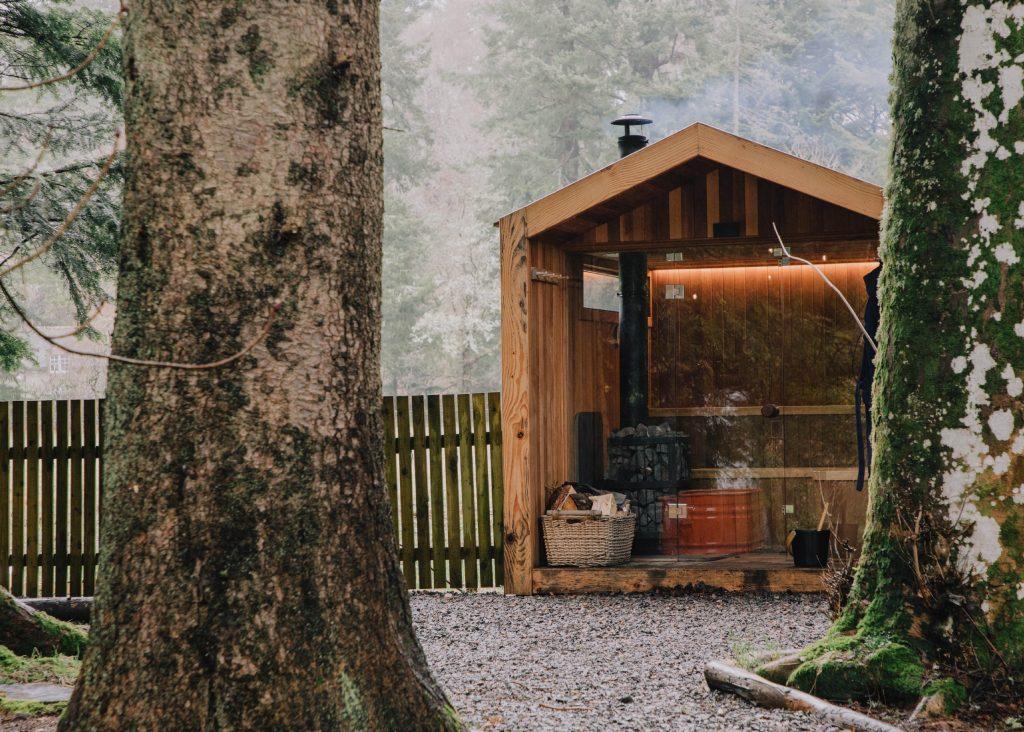
Water, whisky, coffee – a cold water weekend at Glen Dye
Otherwise known as the Nordic Cycle, contrast bathing is a regime where you move between the heat of a sauna to cold water immersion, ending on a cold dunk. Try it at Glen Dye’s new Discovery and Adventure Centre in glorious Aberdeenshire
Standing up to my knees, I wriggle my toes and hold onto the edge of the deep orange metal tub mentally preparing myself to lie down in the eight-degree water. I slow my breathing, inhaling for four counts then exhaling for eight, a technique our instructor Pip Wright calls ‘whisky breathing’, which brings your heart rate down and makes you feel calmer.
“Remember: resilience, grit and determination,” she says, by way of encouragement, before reminding us to take short, sharp and stimulating breaths (or ‘coffee breathing’) as we lower ourselves into the water. Centring myself as best I can, I exhale then sit down in one smooth motion. Getting my neck and shoulders under admittedly takes another 30 seconds.


While we can’t control our mammalian reflexes when entering cold water – to gasp, for instance – we can learn to control our response to it. This is something Pip calls a ‘top down’ control mechanism. An open water and outdoor wellness coach who became the UK’s first female Army Commando, Pip recently starred on Channel 4’s survival programme Alone, where contestants were dropped into the Canadian wilderness, self-filming their battle against the elements to see who can last the longest. She is currently training to swim the Channel.
The Nordic cycle
Prior to getting into the cold tub at Glen Dye, a family estate with design-led cabins and cottages surrounded by 15,000 acres of wilderness, forest and moorland on the banks of the River Dye, Pip had briefed us on the experience in the warmth of the Seed Store. A wooden cabin built in the late 1800s as a kitchen, refuge and seed store for the estate foresters, it now forms part of the newly opened Discovery and Adventure Centre, situated on the estate’s former sawmill.
Otherwise known as the Nordic Cycle, contrast bathing is a regime where you move between the heat of a sauna to cold water immersion, ending on a cold dunk. While the sauna represents exercise, dilating your blood vessels and oxygenating your blood, the cold water contracts your blood vessels – a push and pull effect that boosts your metabolism, improves blood circulation, aids sleep and detoxifies your body. The experience also interacts with your lymphatic system, which is responsible for draining toxins. “Your lymphatic system doesn’t have a pump like your heart, so the contrast bathing helps by adding this push-pull effect,” says Pip.


Immersing yourself in cold water causes a very primitive response in your body. “You release dopamine and endorphins, happy chemicals more potent than morphine, something we call the ‘champagne effect’,” says Pip. It’s best done early in the day, as the body’s natural response is to warm itself up afterwards, which aligns with our body’s natural cycles. The effects can last an hour or two, or perhaps the rest of the day, but be prepared for a slump a little later and go easy on your body, Pip cautions.
The Nordic Cycle has benefits outside of the water, too. “You’re talking to your prefrontal cortex,” says Pip. “If you can take control and breathe through the discomfort, you can take this sense of control and bring it into your everyday life.”
How cold is ‘cold’? “It’s a temperature that makes you feel uncomfortable,” says Pip. Anything under around 15 degrees is considered cold, and below these temperatures even one degree difference feels significant. Of the two tubs we’re using today, one is a little under eight degrees, the other a touch over. We’re instructed to stay in the cold tanks for no longer than five minutes per dunk, with two minutes being the time when you get all the cellular, mental and physiological benefits. We’re to try three cycles of cold then hot, ending with cold.

As Pip talks, we strip pine needles and add them to a Stanley flask, rubbing them between our fingers to bring out the woody, lemony smell. Fur traders would often steep pine needles like this, Pip explains, as they’re a potent source of vitamin C. “The sap rises with the moon,” she says, explaining how the sap is also anti-microbial and anti-fungal. “If you notice the sticky resin on a trunk, that’s the tree healing itself.”
The difficult third dip
After three cold dips and sauna sessions, our group agrees the third dip is by far the hardest. This comes as something as a surprise, as the second dunk actually felt rather pleasant and I was able to take in my surroundings: the gently babbling stream running through the old sawmill, the scent of woodsmoke, an incredible larch archway fitted together by hand. The third has me struggling to contain my shivers and asking Pip how long before I can get out.
After our final cold dip, we dress in warm layers and head to the Library, a private dining space in the main estate, where our host has laid on a Thermos of lentil and sweet potato soup with Scottish cheese and oat cakes, as shaggy haired lurchers pad past the room.
Glen Dye has been in the Gladstone family for seven generations, since the 1840s. Its current owners, Charlie and Caroline Gladstone left their jobs in music and design and moved from London to Aberdeenshire in 1990. Finding a beautiful but neglected house with no heating or functioning electricity, an insolvent business, over 20 houses in derelict or uninhabitable condition and several farms in need of love, they set about renovating and restoring the estate – a work of “passion bordering on insanity” that took over 25 years. In 2018, they launched Glen Dye Cabins and Cottages, an opportunity to welcome people into this magical setting.



Our group is staying in the Coach House. Originally an 1840s farm steading built in pink granite, it’s now a festival of colour, with a considered taste that makes me want to reconsider my design choices back home. Miniature libraries of nature and cookery books line the window sills, radios replace TV screens and an antique juke box links the generous kitchen with a comfy lounge.
Caroline, who spends most of her time at Glen Dye, chooses the paint colours while husband Charlie, who heads up the Hawarden Estate in North Wales, fills each of the nine properties with modern art and artefacts from auctions and antique markets. Roaring fires are encouraged; firewood is unlimited and stacked in pleasing piles throughout the grounds. “If you don’t go home smelling of wood smoke, we haven’t done our job well,” says Caroline.
A dip in the Dye
We spend the afternoon around a campfire with Pip’s husband, Stu Wright, as he teaches us bushcraft skills for outdoor swimmers. We whittle a wooden hook, which you can tie around a tree to hang a towel or changing robe. We make fire from scratch, striking sparks into charred pieces of cloth then holding a smoking nest of straw in our hands as the wind sets it alight. We learn a knot for tying wet towels to our backpacks. We drink tea in enamel mugs and get to know each other better.



The following day, fuelled on sourdough and croissants dropped off earlier that morning, we hike from the door to the summit of nearby Clachnaben, a much-loved ‘small hill’ with magnificent views from its granite tor, then descend to the River Dye for a dunk in its peaty water. Scrambling down to submerged pink granite rocks, we let the current take us deep into a mossy ravine. At 12 degrees, the water feels balmy compared to the tanks, and we swim with a new found confidence in the cola coloured water.




Ravenous, we return to find another delicious lunch – this time laid out for us in The Glen Dye Arms, housed in what used to be the farm’s laundry. Affectionately known as “The Best Pub in Scotland”, the tiny BYOB pub feels like a bothy, a shared space with a wood burning stove, record player and proper wooden bar.


After three days of cold dips, hearty food and fresh Scottish air, I’m eager to settle into my bunk on the Caledonian Sleeper, a delightfully civilised way to travel to London. I always find there’s such a romance to overnight train travel: the sense of possibility and promise of adventure; that wondrous ‘ta-da!’ feeling of falling asleep in one place and waking up in another. The Caledonian Sleeper is no exception. After a nip of whisky and a few rounds of cards, I retire to my berth and, clothes still smelling of woodsmoke, drift off to sleep lulled by the motion of the train.
Stay at The Coach House at Glen Dye from £175 per room or from £1,000 per night for exclusive use (sleeps 12). A half-day Nordic Cold Water or Fire Making taster session cost £25 per person; glendyecabinsandcottages.com. Travel on the Caledonian Sleeper in a Classic Room costs from £190 for solo or £240 for shared accommodation; sleeper.scot. Photos: Jo Tinsley; Glen Dye.
Read the June ‘Swim Hiking’ issue on Outdoor Swimmer EXTRA. Read more swim travel features.








